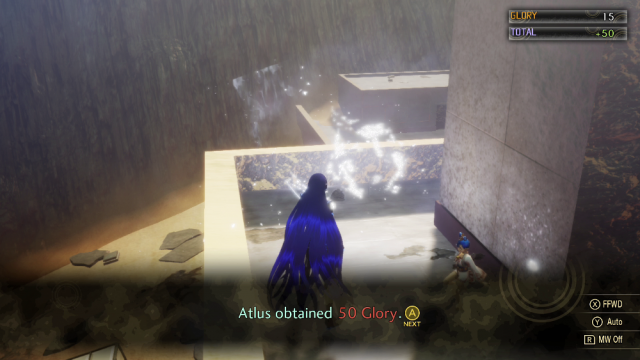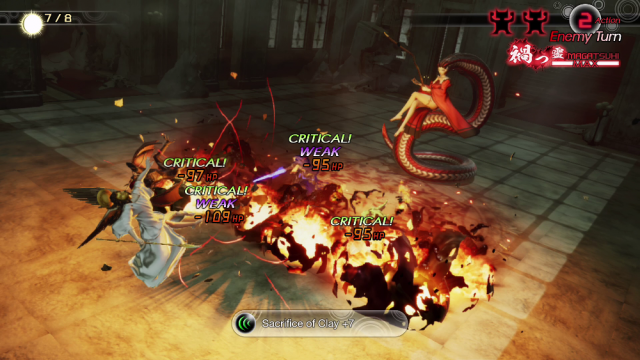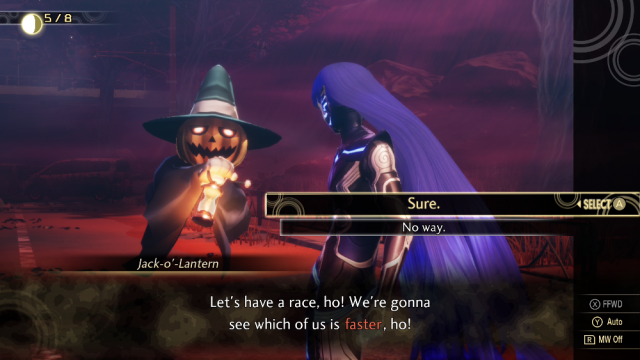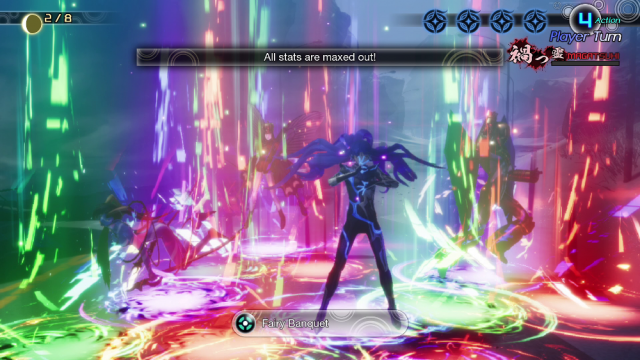Existing User Log In
New User Registration
Register for a free account to gain full access to the VGChartz Network and join our thriving community.





America - Front


America - Back

Role-playing games, in general, have a way of overwhelming your schedule and expanding your backlog, but the Shin Megami Tensei series is especially dangerous. It's so rich in content, side-quests, and opportunities for experimentation — and so alluring — that it's difficult to put down days, weeks, and even months later. Shin Megami Tensei V (SMTV), the latest mainline installment of the long-running RPG franchise, continues this rule.
SMTV takes place in modern-day Tokyo and centers around a cadre of high-school classmates. During the long walk from school to the dormitories on the other side of town, our hero — named by you, the player — runs into a grisly murder scene in the subway. He takes a detour through a shadowy tunnel north of the tracks and, after an unexpected and unexplained cave-in, awakens in a twisted, post-apocalyptic version of Tokyo: Da'at, the land of demons. There he meets a unique demon who merges with him to form a powerful being called a Nahobino, neither human nor demon. From then on, our hero will explore the demonic wasteland, search for clues about the disappearance of Tokyo, and ultimately decide on a path between light and dark.

Almost everything works with the story in SMTV. The post-apocalyptic setting is intriguing, and the mythology and politics of its demonic citizens are endlessly entertaining. Furthermore, keeping with the themes of previous Shin Megami Tensei games, there's a refreshingly nuanced take on all things light and dark. There are heroes, villains, fools, and allies on both sides — whether demonic or angelic. The only flaw: the personalities of your classmates are a bit clichéd.
Story inevitably takes a backseat to the heart of the game: exploration, turn-based combat, and demon fusion. It's in these areas where SMTV enters into game-of-the-year contention.
Exploring post-apocalyptic Tokyo is a joy. Aesthetically, it hits all the right notes, thanks to ruined buildings, mountains of sand, and the rusty carcasses of cars, trains, and other man-made machines. On the gameplay front, it provides plenty of opportunities to strike off the beaten path to discover consumable items, demonic essences, guest-giving NPCs, or super-strong demons. In many instances, you'll have to map out the terrain to understand the correct path to the prize. You might, for example, need to drop through a warehouse window to find a friendly demon or ascend a collapsed skyscraper to locate a physical dampener.

Searching high and low throughout ruined Tokyo will take some time — there's a lot of demonic real estate after all — but luckily the developers at Atlus have provided two useful tools as you bounce back and forth across the demon-infested dunes of Da'at: multiple fast-travel nodes and the ability for the Nahobino to auto-run. Simply press the two shoulder buttons at once and the main character will run forward automatically; all you need to do is steer.
Inevitably, whether running or walking, you'll collide with a roaming demon and trigger a battle. Combat in SMTV is a whole lot of fun, in part due to the tactical ramifications of the Press Turn Battle System and in part due to the ability to conduct conversations and negotiations with demonic enemies during most fights.
Let's break down Press Turn first. SMTV unfolds during battle mostly like a typical turn-based Japanese role-playing game: the allied and opposing parties take turns attacking, casting spells, using items, and triggering buffs and debuffs. What allows this game to stand out is Press Turn, which grants each side of the battle a specific number of actions per turn represented by a row of icons in the top right corner of the screen. If you manage to land a critical hit or take advantage of an enemy's elemental weakness, you can gain additional actions. For example, if each of your four party members strike a Jack-o'-Lantern with "bufu" (ice) attacks, you'll end up with up to 8 actions per move — four more than usual. Conversely, if you deploy a bufu attack against an ice-based enemy shielded against bufu, you could end your turn prematurely.

Interestingly, this Press Turn framework applies to your enemies as well. As a result, you must be careful to curate your party in a way to both push your advantage in battle and guard against enemies building up additional turns and decimating your ranks before you know what hit you. It all makes for a wonderfully strategic and intellectual chess match, both on a micro level as you exchange individual party members during battle, and a macro level as you customize your party's composition to overcome certain regions and bosses.
Battles don't always end with deadly results, however. A big piece of the Shin Megami Tensei experience is actually talking with demons and attempting to recruit them to your side. This is one of the most exciting and unpredictable parts of the game. Depending on the demon's level, affinity, and mood, it might agree to join you. You'll have to choose the right dialogue prompts, however, and monitor certain other variables, for example the fullness of the moon. You'll also need to provide the right gifts and potentially hand over large sums of macca, the game's currency. Pro tip: try to find a Jirae talisman, which unlocks a special ability called "Sincerity" that forgives up to two mistakes during demon negotiation.

What's particularly meaningful about these demonic exchanges, apart from the immediate rewards of expanding your party with a new, powerful ally, is the dialogue itself. Each demon has a specific personality, based in part on its race, that reveals itself in conversation. It's fascinating to see what excites and turns off individual demons, and to observe the unintended consequences of certain words and actions. Sometimes, even your party members will get in on the action. During one battle about halfway through the game, my allied Cironnup (the cutest demon in the game) started talking to an enemy Koropokkuru about how they both used to live in Hokkaido. These kinds of small details give tremendous depth to the world of SMTV.
Despite your silver tongue and deep pockets, you might not be able to win over every demon via negotiation. Luckily, there's demon fusion. From the World of Shadows, accessible from every fast-travel node, you can fuse demons in your party to create more dominant types and variants. This is by far the most addictive aspect of the game. You can experiment almost endlessly by mixing and matching demon types, and creating allies who will inherit new skills. There is also Special Fusion, which uses three or even four demons to create a uniquely powerful ally.

Demon fusion can, at times, be a little overwhelming, but fortunately the game provides a "reverse fusion" option that shows, at a glance, all the available demons based on your current party. There's even a "reverse compendium fusion" option that lists all possible demon fusions based on your current party and any demons you've registered who have since left your party.
In addition to demon fusion, the game supports essence fusion, whereby players can grant the Nahobino the skills or the affinities of other demons. If you're struggling against lightning attacks, you could adopt the essence of Neko Shogun to guard against any type of electricity. Or if you need to use dark attacks moving forward, you might consider drawing from Baphomet's skill pool.
You will absolutely need to lean on both demon and essence fusion to survive Da'at. SMTV is a very challenging game, even on normal difficulty. You might be able to power through battles with rank-and-file enemies with only a half-hearted approach to elemental synergies and weakness, but you will be stopped cold by bosses unless you carefully and thoughtfully plan out your party composition and strategy. While this can lead to some frustrating encounters, it's ultimately a good thing. "Normal" difficultly has lost some of its bite over the last few generations; in SMTV, it's no joke.

Due to several stops and starts owing to the steep difficulty, and because of the overall size and scope of the game, SMTV is a very long experience. It will take approximately 60 hours to reach the end and close to 100 to see and unlock everything.
While SMTV achieves greatness in a number of categories, it falters when it comes to the technical side of things. The game is very ambitious — it's fully rendered in 3D utilizing Unreal Engine 4, a first for the mainline series — but it struggles to keep up in a few key areas. The framerate doesn't always hold to a steady 30 FPS, and there's pop-in galore (the latter is especially evident in the Fairy Village, as grass emerges from nowhere only yards in front of you). The most distracting element, though, might be draw distance. The animations of characters about ten yards away lose frames, turning them into weird slideshows of themselves. Finally, in portable mode, the game looks a little washed out.

Other than these technical shortcomings, the visual component of the game is solid. The apocalyptic art direction and graphical flourishes are great, and indeed help distract from any technological hiccups. The soundtrack, similarly, is outstanding. Each zone in Da'at has its own musical identity, sometimes invigorating, sometimes somber, sometimes otherworldly. Perhaps the best tune is "Da'at: Tamachi", an alien tune that's reminiscent of Taito's house band Zuntata.
If you can look past some technical warts, you'll find in Shin Megami Tensei V one of the best games of the year. It's an enticing turn-based RPG with a fascinating premise, tactical combat, tons of content, challenging gameplay, and an addictive demon fusion framework that alone will occupy hours of your time. If you're a Switch owner and an RPG fan, this one is a no-brainer. Just be prepared to wipe your calendar clean for the next month or so.









